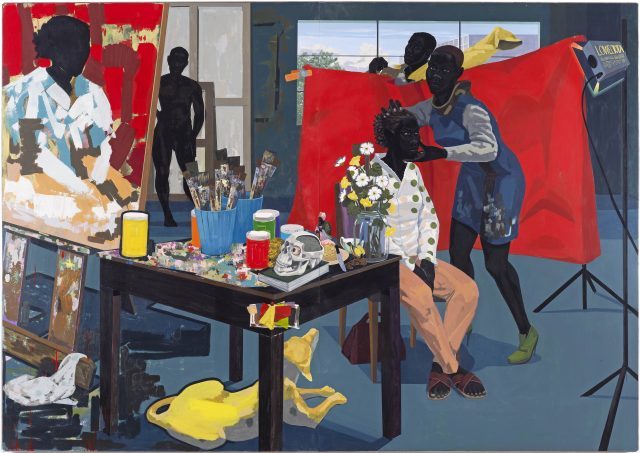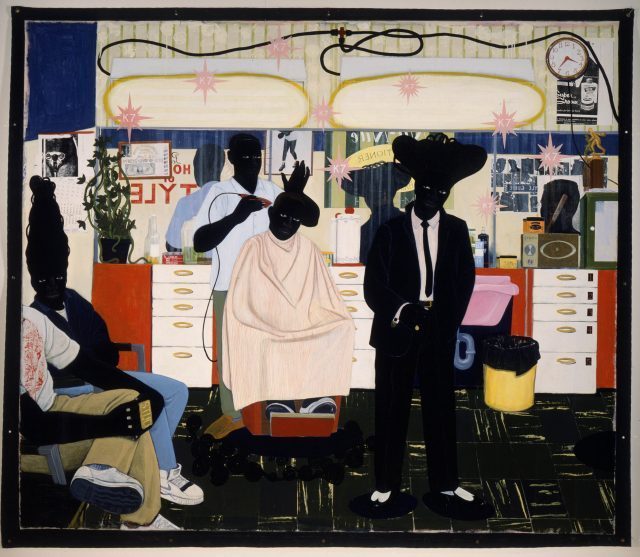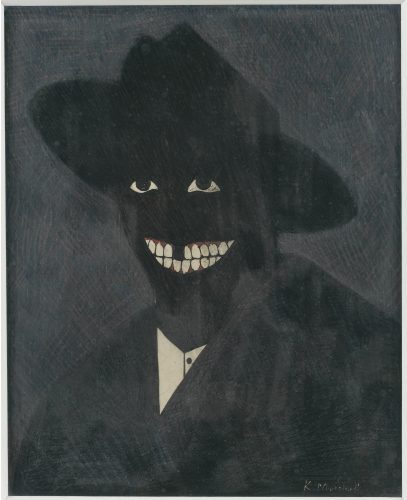
Kerry James Marshall, “Untitled (Studio),” acrylic on PVC panels, 2014 (the Metropolitan Museum of Art Purchase, the Jacques and Natasha Gelman Foundation Gift, Acquisitions Fund and the Metropolitan Museum of Art Multicultural Audience Development Initiative Gift, 2015 © Kerry James Marshall)
The Met Breuer, third and fourth floors
945 Madison Ave. at 75th St.
Tuesday – Sunday through January 29, suggested admission $12-$25
212-731-1675
www.metmuseum.org
The Met Breuer’s exciting inaugural year continues with the timely and revelatory “Kerry James Marshall: Mastry,” a beautifully curated retrospective that arrives as the country remains split over the Black Lives Matter movement and shortly after the gutting of the Civil Rights Voting Act. Marshall, who was born in Birmingham, Alabama, in 1955, moved to Los Angeles when he was seven, and has lived and worked in Chicago for more than twenty-five years, investigates sociocultural mores through an art-historical lens in his work, which primarily consists of dramatic large-scale canvases that often echo classic paintings from the Western canon. Initially inspired by Ralph Ellison’s Invisible Man, Marshall peoples his paintings with men, women, and children of such a deep, dark, rich black that they sometimes almost disappear. The show begins on the third floor with a pair of powerful side-by-side acrylic-and-collage 1993 works that set the stage for the rest of the exhibition. “De Style” depicts a scene in a barbershop, a traditional gathering place for African Americans, evoking an Old Master painting while also referencing the Dutch art movement known as De Stijl, which focused on the fusion of form and function. Four men, so dark that their eyes are nearly disembodied from their faces, look directly at the viewer. Marshall fills the shop with intricate details and geometric splashes of color, from rectangular blues and reds to a yellow trashcan and a pink sink, but it’s the black that grabs the viewer’s attention. Next to “De Style” is “The Lost Boys,” which pays tribute to two black children who were killed by guns. The canvas features a blue-leafed tree wrapped in yellow police tape, a red background, a haloed orange votive figure, and, between the two boys, the word “Power.” At the press preview, Marshall, a graduate of the Otis Art Institute in Los Angeles, highlighted a quote from University of Chicago professor W. J. T. Mitchell’s What Do Pictures Want?, “a phrase that really defines what it means for me to be an artist: ‘Images don’t only express our desires, they teach us how to desire in the first place.’” He continued, “And for me, that seems to encapsulate fully everything that I experienced in my first encounter with images that brought me to this place, and because I understand something about the power of images, and things you see actually matter, and the more things you see that are different from each other, the more it matters. And when you come to the museum, if you only saw images that were out of the European tradition, and you never saw images that came from another perspective or that pictured other people, and not just incidentally or every now and then but in substantial and critical mass, then there’s always going to be something missing, something missing that I think really cripples our ability to imagine the world in the fullness of its possibility.” Starting the exhibit with “De Style” and “The Lost Boys” immediately places you within Marshall’s world, one that you don’t usually see in museums.

Kerry James Marshall, “De Style,” acrylic and collage on canvas, 1993 (Los Angeles County Museum of Art, © Kerry James Marshall)
Marshall is an exquisitely talented, technically adroit artist, with a compelling sense of color and perspective, creating affecting narrative works with simple yet bold stories to tell. The canvases might reference Rembrandt, Boucher, Fragonard, Holbein, Hopper, Stella, Newman, and various genres throughout the centuries, but they are so much more than that. In “Beauty Examined,” a dead woman is on a slab; her body is all the same dark black except for her left arm, from which the skin has been removed, revealing muscles and bones alongside which Marshall writes, “Beauty is only skin deep.” In “Slow Dance,” a black couple sways romantically to the Originals’ “Baby I’m for Real,” the musical notes floating in the background of an otherwise naturalistic domestic scene. “School of Beauty, School of Culture” is a companion piece to “De Style,” this time set in a women’s hair salon, where, in the front, a young child is looking at the twisted anamorphic head of Walt Disney’s Sleeping Beauty floating like an ever-present Caucasian ghost. The five spectacular large-scale paintings that make up the Garden Project, which depict ordinary life in public housing developments, envelop visitors in their celebration of the everyday while threats are never far away. People are most familiar with photographs of Harriet Tubman that show her as an old, stern woman, but Marshall humanizes her in “Still Life with Wedding Portrait,” depicting her as a younger, sexually attractive woman standing in front of her husband; the painting within the painting is being handled by four gloved hands, three white, one black. And in “Portrait of Nat Turner with the Head of His Master,” the leader of the 1831 slave rebellion in Virginia stands in the foreground holding an ax, his ghostly master lying behind him in bed, his head separated from the res of his body.

Kerry James Marshall, “A Portrait of the Artist as a Shadow of His Former Self,” egg tempera on paper, 1980 (Collection of Steven and Deborah Lebowitz, © Kerry James Marshall; photo: Matthew Fried, © MCA Chicago)
In Invisible Man, Ellison wrote, “I am invisible, understand, simply because people refuse to see me.” Marshall takes that thought to bear in much of his work, including such pieces as “A Portrait of the Artist as a Shadow of His Former Self,” which is dominated by a man with a Cheshire-cat-like smile with a missing front tooth; “Two Invisible Men (The Lost Portraits),” consisting of two portraits, one completely white, the other showing the artist smiling, his eyes glowing in the darkness; “Untitled (Studio),” a dazzling tour de force that is one of the five hundred works that make up the new book The Metropolitan Museum of Art: Masterpiece Paintings; and “Black Artist (Studio View),” a blue-tinted inkjet print of the artist working on the Hopper-inspired “7 am Sunday Morning,” only the sleeve of his white shirt at first visible, a representation of how photography was optimized for white skin tones. Other works to watch out for are “Voyager,” the comic-book-like “Rhythm Mastr,” “Past Times,” and the photography installation “Art of Hanging Pictures,” which again emphasizes the kinds of subjects and scenes not usually on display in museums unless attached to a specific political or social theme. The exhibition is supplemented by “Kerry James Marshall Selects,” more than three dozen works chosen by Marshall from the Met’s collection, including paintings by Jean Auguste Dominique Ingres, Albrecht Dürer, Jacob Lawrence, Georges Seurat, Frank Stella, Paul Cadmus, Ad Reinhardt, Paolo Veronese, Horace Pippin, Walker Evans, and Tsukioka Yoshitoshi, lending further insight into Marshall’s taste and inspirations. You can find out even more about Marshall at three special events being held in conjunction with the exhibition, which runs through January 29. On December 15 at 6:30, “An Evening with Kerry James Marshall” takes place at the Met Fifth Ave., in the Grace Rainey Rogers Auditorium, with Marshall discussing his career with journalist William C. Rhoden; although it is sold out, it will be live-streamed on the Met’s Facebook page. On January 27, the MetFridays program “Art School — The Studio” features artist-led drawing sessions and curator talks from 6:30 to 8:30 at the Met Fifth Ave. and the Met Breuer; and on January 28, the all-day symposium “Kerry James Marshall — A Creative Convening” brings together Marshall, Black Girls Code founder Kimberly Bryant, Olympic gold medalist Michelle Carter, director and cinematographer Arthur Jafa, physicist Hank Thomas, vocalist and composer Imani Uzuri, exhibition cocurators Helen Molesworth and Ian Alteveer, and others for an examination of Marshall’s work and putting it in context in today’s society.